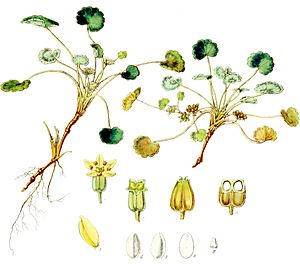Azorella schizeilema facts for kids
Quick facts for kids Azorella schizeilema |
|
|---|---|
 |
|
| A. schizeilema as Pozoa reniformis (Plate XI - Walter Fitch) | |
| Conservation status | |
|
Invalid status (NZ TCS)
|
|
| Scientific classification | |
| Genus: |
Azorella
|
| Species: |
schizeilema
|
| Synonyms | |
|
Pozoa reniformis Hook.f. |
|
Azorella schizeilema is a special type of cushion plant. It belongs to the Apiaceae family, which also includes carrots and parsley! This unique plant grows naturally on the Auckland and Campbell Islands, which are far-off islands south of New Zealand.
This plant blooms with flowers from November to February. It then produces fruits from November to March.
Contents
What is a Cushion Plant?
A cushion plant is a type of plant that grows in a very dense, low, mat-like shape. Imagine a super thick, green pillow on the ground. This special way of growing helps the plant survive in harsh, windy places. It protects the plant from cold temperatures and strong winds.
Where Does Azorella schizeilema Live?
This plant is native to the Auckland and Campbell Islands. These islands are part of New Zealand's subantarctic islands. They are known for their wild weather and unique wildlife. The plant thrives in these cool, often windy environments.
How Scientists Name Plants
Scientists give plants special names to help everyone know exactly which plant they are talking about. Azorella schizeilema has had a few name changes over the years!
- In 1844, a scientist named Joseph Dalton Hooker first described it. He called it Pozoa reniformis.
- Later, in 1908, Karel Domin moved it to a different group, calling it Schizeilema reniforme.
- Then, in 2017, G.M.Plunkett and A.N.Nicolas gave it its current name, Azorella schizeilema. They did this to make sure all plants in the Azorella group were closely related.
Is This Plant Safe?
The conservation status of Azorella schizeilema is "At Risk - Naturally Uncommon." This means the plant is not in immediate danger of disappearing, but it's not very common either.
- It was given this status in 2009, 2012, and again in 2018.
- The main reason it's "Naturally Uncommon" is because it only grows in a small area. It's found only on the Auckland and Campbell Islands. This limited home makes it special and important to protect.

